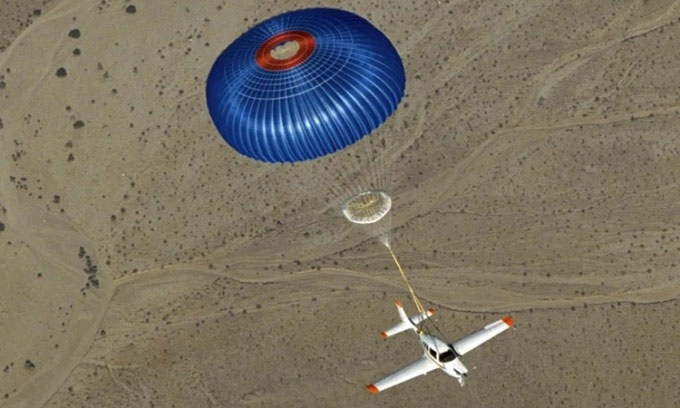The parachute system helps planes in distress land safely
Since going into operation, the Cirrus Airframe parachute system has helped save the lives of 249 people on planes with engine problems or unexpected incidents.
American company Cirrus Aircraft's Cirrus Airframe parachute system (CAPS) has contributed to changing small aircraft travel, according to Simple Flying . The idea of using parachutes for entire aircraft has existed since the early days of aviation with many design efforts, although no product has yet proven practical or effective.

The Cirrus Airframe parachute system helps the aircraft lower its altitude in a balanced position and land safely. (Photo: Smithsonian Magazine).
In March 2023, in a serious accident, CAPS saved the lives of 6 people on the Cirrus SR22 aircraft, including a 3-year-old baby and a newborn baby. Not long after taking off from Pampulha airport in Brazil, the plane suffered engine failure. Realizing that the hover range was not enough to return to the airport, the pilot decided to deploy CAPS. As a result, SR22 flew by parachute in the air and landed safely without any passengers being injured.
Previously in 1982, Ballistic Recovery Systems (BRS) company made a breakthrough when it began producing parachutes for ultra-light aircraft. According to Cirrus Aircraft, the milestone occurred in 1993 when BRS developed a specialized parachute system for Cessna 150/152 aircraft. However, this expansion system is very expensive, heavy and takes up a lot of luggage space. The result of a partnership between Cirrus Aircraft and BRS in the 1990s, CAPS brought about a major change in safety. CAPS is an integrated safety net designed to be deployed in emergency situations where traditional methods may not be suitable.
The CAPS parachute system covers the entire airframe, specialized for light aircraft such as the SR20, SR22, and Vision SF50. CAPS was licensed by the US Federal Aviation Administration (FAA) in October 1998. To date, this is still the first and only ballistic parachute used as standard equipment on aircraft.
When experiencing engine problems or facing unexpected challenges during flight, pilots can activate the parachute system simply by pulling the joystick in the cockpit. This action will trigger the parachute rocket to deploy in mid-air, pulling the entire aircraft with it. The parachute system deploys in a controlled manner, ensuring the aircraft flies gradually lower with two balanced wings, finally landing safely on the ground or water. This safety equipment attracts a lot of attention due to its ability to reduce the severity of emergencies. According to the New York Post, CAPS saved 249 lives.
- NASA tested the new launch system
- Why does the passenger plane have no parachute jump?
- The system helps pilots land when they don't see the runway
- Many flights at the same time, why is QZ8501 only in distress?
- This is what happens if an airplane suddenly raises the gear when it starts to land
- The system helps to drive safely
- The first one jumped out of an airplane at an altitude of 25,000 feet without a parachute
- Cats always land on their feet
- Nearly die with a free fall with
- The weirdness of geography: How were islands born?
- Mars exploration robots will land harassment
- How the plane took off on the solar system planets
 'Barefoot engineer' invents a pipeless pump
'Barefoot engineer' invents a pipeless pump Process of handling dead pigs due to disease
Process of handling dead pigs due to disease Radiometer
Radiometer Warp Engine: Technology brings us closer to the speed of light
Warp Engine: Technology brings us closer to the speed of light